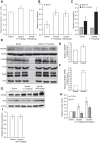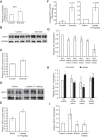Lactate Mediates the Effects of Exercise on Learning and Memory through SIRT1-Dependent Activation of Hippocampal Brain-Derived Neurotrophic Factor (BDNF)
- PMID: 30692222
- PMCID: PMC6435829
- DOI: 10.1523/JNEUROSCI.1661-18.2019
Lactate Mediates the Effects of Exercise on Learning and Memory through SIRT1-Dependent Activation of Hippocampal Brain-Derived Neurotrophic Factor (BDNF)
Abstract
Exercise promotes learning and memory formation. These effects depend on increases in hippocampal BDNF, a growth factor associated with cognitive improvement and the alleviation of depression symptoms. Identifying molecules that are produced during exercise and that mediate hippocampal Bdnf expression will allow us to harness the therapeutic potential of exercise. Here, we report that an endogenous molecule produced during exercise in male mice induces the Mus musculus Bdnf gene and promotes learning and memory formation. The metabolite lactate, which is released during exercise by the muscles, crosses the blood-brain barrier and induces Bdnf expression and TRKB signaling in the hippocampus. Indeed, we find that lactate-dependent increases in BDNF are associated with improved spatial learning and memory retention. The action of lactate is dependent on the activation of the Sirtuin1 deacetylase. SIRT1 increases the levels of the transcriptional coactivator PGC1a and the secreted molecule FNDC5, known to mediate Bdnf expression. These results reveal an endogenous mechanism to explain how physical exercise leads to the induction of BDNF, and identify lactate as a potential endogenous molecule that may have therapeutic value for CNS diseases in which BDNF signaling is disrupted.SIGNIFICANCE STATEMENT It is established that exercise promotes learning and memory formation and alleviates the symptoms of depression. These effects are mediated through inducing Bdnf expression and signaling in the hippocampus. Understanding how exercise induces Bdnf and identifying the molecules that mediate this induction will allow us to design therapeutic strategies that can mimic the effects of exercise on the brain, especially for patients with CNS disorders characterized by a decrease in Bdnf expression and who cannot exercise because of their conditions. We identify lactate as an endogenous metabolite that is produced during exercise, crosses the blood-brain barrier and promotes hippocampal dependent learning and memory in a BDNF-dependent manner. Our work identifies lactate as a component of the "exercise pill."
Keywords: BDNF; PGC1a; Sirt1; exercise; learning; memory formation.
Copyright © 2019 the authors 0270-6474/19/392369-14$15.00/0.
Figures








References
Publication types
MeSH terms
Substances
LinkOut - more resources
Full Text Sources
Medical
Molecular Biology Databases
